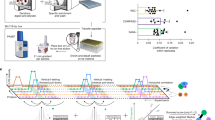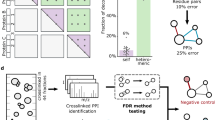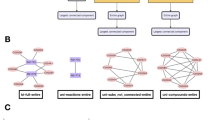Abstract
We introduce a general computational method, applicable on a genome-wide scale, for the systematic discovery of uncharacterized cellular systems. Quantitative analysis of the coinheritance of pairs of genes among different organisms, calculated using phylogenetic profiles, allows the prediction of thousands of functional linkages between the corresponding proteins. A comparison of these functional linkages to known pathways reveals that calculated linkages are comparable in accuracy to genome-wide yeast two-hybrid screens or mass spectrometry interaction assays. In aggregate, these linkages describe the structure of large-scale networks, with the resulting yeast network composed of 3,875 linkages among 804 proteins, and the resulting pathogenic Escherichia coli network composed of 2,043 linkages among 828 proteins. The search of such networks for groups of uncharacterized, linked proteins led to the identification of 27 novel cellular systems from one nonpathogenic and three pathogenic bacterial genomes.
This is a preview of subscription content, access via your institution
Access options
Subscribe to this journal
Receive 12 print issues and online access
$209.00 per year
only $17.42 per issue
Buy this article
- Purchase on Springer Link
- Instant access to full article PDF
Prices may be subject to local taxes which are calculated during checkout






Similar content being viewed by others
References
Marcotte, E.M. Computational genetics: finding function by non-homology methods. Curr. Opin. Struct. Biol. 10, 359–365 (2000).
Huynen, M., Snel, B., Lathe, W. & Bork, P. Exploitation of gene context. Curr. Opin. Struct. Biol. 10, 366–370 (2000).
Pellegrini, M., Marcotte, E.M., Thompson, M.J., Eisenberg, D. & Yeates, T.O. Assigning protein functions by comparative analysis: protein phylogenetic profiles. Proc. Natl. Acad. Sci. USA 96, 4285–4288 (1999).
Overbeek, R., Fonstein, M., D'Souza, M., Pusch, G. & Maltsev, N. The use of gene clusters to infer functional coupling. Proc. Natl. Acad. Sci. USA 96, 2896–2901 (1999).
Tavazoie, S., Huges, J.D., Campbell, M.J., Cho, R.J. & Church, G.M. Systematic determination of genetic network architecture. Nat. Gen. 22, 281–285 (1999).
Marcotte, E.M., Pellegrini, M., Ng, H.-L., Rice, D.W., Yeates, T.O. & Eisenberg, D. Detecting protein function and protein-protein interactions from genome sequences. Science 285, 751–753 (1999).
Enright, A.J., Iliopoulos, I., Kyrpides, N.C. & Ouzounis, C.A. Protein interaction maps for complete genomes based on gene fusion events. Nature 402, 86–90 (1999).
Marcotte, E.M., Pellegrini, M., Thompson, M.J., Yeates, T. & Eisenberg, D. A combined algorithm for genome-wide prediction of protein function. Nature 402, 83–86 (1999).
Dandekar, T., Snel, B., Huynen, M. & Bork, P. Conservation of gene order: a fingerprint of proteins that physically interact. Trends Biochem. Sci. 23, 324–328 (1998).
Eisenberg, D., Marcotte, E.M., Xenarios, I. & Yeates, T.O. Protein function in the post-genomic era. Nature 405, 823–826 (2000).
Salgado, H., Moreno-Hagelsieb, G., Smith, T.F. & Collado-Vides, J. Operons in Escherichia coli: genomic analyses and predictions. Proc. Natl. Acad. Sci. USA 97, 6652–6657 (2000).
Thompson, H.G.R, Harris, J.W, Wold, B.J, Quake, S.R & Brody, J.P. Identification and confirmation of a module of coexpressed genes. Genome Res. 12, 1517–1522 (2002).
Tong, A.H. et al. Systematic genetic analysis with ordered arrays of yeast deletion mutants. Science 294, 2364–2368 (2001).
Uetz, P. et al. A comprehensive analysis of protein-protein interactions in Saccharomyces cerevisiae. Nature 403, 623–627 (2000).
Ito, T. et al. A comprehensive two-hybrid analysis to explore the yeast protein interactome. Proc. Natl. Acad. Sci. USA 98, 4569–4574 (2001).
Ho, Y. et al. Systematic identification of protein complexes in Saccharomyces cerevisiae by mass spectrometry. Nature 415, 180–183 (2002).
Gavin, A. et al. Functional organization of the yeast proteome by systematic analysis of protein complexes. Nature 415, 141–147 (2002).
Pavlidis, P., Weston, J., Cai, J. & Grundy, W.N. Learning gene functional classifications from multiple data types. J. Comp. Biol. 9, 401–411 (2002).
Shannon, C.E. A mathematical theory of communication. Bell System Technical Journal 27, 379–423, 623–656 (1948).
Krober, B.T.M, Farber, R.M., Wolpert, D.H. & Lapedes, A.S. Covariation of mutations in the V3 loop of human immunodeficiency virus type I envelope protein: an information theoretic analysis. Proc. Nat. Acad. Sci. USA 90, 7176–7180 (1993).
Huynen, M., Snel, B., Lathe, W. & Bork, P. Predicting protein function by genomic context: quantitative evaluation and qualitative inferences. Genome Res. 10, 1204–1210 (2000).
Blattner, F.R. et al. The complete genome sequence of Escherichia coli K-12. Science 277, 13–1474 (1997).
Goffeau, A. et al. The yeast genome directory. Nature 387, Supplement (1997).
Kanehisa, M. & Goto, S. KEGG: Kyoto encyclopedia of genes and genomes. Nucleic Acids Res. 28, 27–30 (2000).
Xenarios, I. et al. DIP: the database of interacting proteins: 2001 update. Nucleic Acids Res. 29, 239–241 (2001).
McAteer, S., Coulson, A., McLennan, N. & Masters, M. The lytB gene of Escherichia coli is essential and specifies a product needed for isoprenoid biosynthesis. J. Bacteriol. 183, 7403–7407 (2001).
Cunningham, F.X. Jr., Lafond, T.P. & Gantt, E. Evidence of a role for LytB in the nonmevalonate pathway of isoprenoid biosynthesis. J. Bacteriol. 182, 5841–5848 (2000).
Takahashi, S., Kuzuyama, T., Watanabe, H. & Seto, H. A 1-deoxy-D-xylulose 5-phosphate reductoisomerase catalyzing the formation of 2-C-methyl-D-erythritol 4-phosphate in an alternative nonmevalonate pathway for terpenoid biosynthesis. Proc. Natl. Acad. Sci. USA 95, 9879–9884 (1998).
Herz, S. et al. Biosynthesis of terpenoids: YgbB protein converts 4-diphosphocytidyl-2C-methyl-D-erythritol 2-phosphate to 2-C-methyl-D-erythritol 2,4-cyclodiphosphate. Proc. Natl. Acad. Sci. USA 97, 2486–2490 (2000).
Delneri, D., Gardner, D.C., Bruschi, C.V. & Oliver, S.G. Disruption of seven hypothetical aryl alcohol dehydrogenase genes from Saccharomyces cerevisiae and construction of a multiple knock-out strain. Yeast 15, 1681–1689 (1999).
Traff, K.L., Jonsson, L.J. & Hahn-Hagerdal, B. Putative xylose and arabinose reductases in Saccharomyces cerevisiae. Yeast 19, 1233–1241 (2002).
Galperin, M.Y., Nikolskaya, A.N. & Koonin, E.V. Novel domains of the prokaryotic two-component signal transduction systems. FEMS Microbiol. Lett. 203, 11–21 (2001).
Amabile-Cuevas, C.F. & Demple, B. Molecular characterization of the soxRS genes of Escherichia coli: two genes control a superoxide stress regulon. Nucleic Acids Res. 19, 4479–4484 (1991).
Gentschev, I., Dietrich, G. & Goebel, W. The E. coli α-hemolysin secretion system and its use in vaccine development. Trends Microbiol. 1, 39–45 (2002).
Braun, V. & Braun, M. Active transport of iron and siderophore antibiotics. Curr. Opin. Microbiol. 2, 194–201 (2002).
Bouveret, E. et al. Analysis of the Escherichia coli Tol–Pal and TonB systems by periplasmic production of Tol, TonB, colicin, or phage capsid soluble domains. Biochimie 84, 413–421 (2002).
Garrett, T.A., Que, N.L. & Raetz, C.R. Accumulation of a lipid A precursor lacking the 4'-phosphate following inactivation of the Escherichia coli lpxK gene. J. Biol. Chem. 273, 12457–12465 (1998).
Tzeng, Y.L., Datta, A., Kolli, V.K., Carlson, R.W. & Stephens, D.S. Endotoxin of Neisseria meningitidis composed only of intact lipid A: inactivation of the meningococcal 3-deoxy-D-manno-octulosonic acid transferase. J. Bacteriol. 184, 2379–2388 (2002).
Rodriguez, E., Banchio, C., Diacovich, L., Bibb, M. & Gramajo, H. Role of an essential acyl coenzyme A carboxylase in the primary and secondary metabolism of Streptomyces coelicolor A3(2). Appl. Environ. Microbiol. 9, 4166–4176 (2001).
Grundling, A., Manson, M. & Young, R. Holins kill without warning. Proc. Natl. Acad. Sci. USA 98, 9348–9352 (2001).
Mengin-Lecreulx, D., van Heijenoort, J. & Park, J.T. Identification of the mpl gene encoding UDP-N-acetylmuramate: L-alanyl-gamma-D-glutamyl-meso-diaminopimelate ligase in Escherichia coli and its role in recycling of cell wall peptidoglycan. J. Bacteriol. 178, 5347–5352 (1996).
Eisen, J.A. & Wu, M. Phylogenetic analysis and gene functional predictions: phylogenomics in action. Theor. Popul. Biol. 61, 481–487 (2002).
Vert, J.P. A tree kernel to analyse phylogenetic profiles. Bioinformatics 1, 276–284 (2002).
Verjovsky Marcotte, C.J. & Marcotte, E.M. Predicting functional linkages from gene fusions with confidence. Appl. Bioinformatics 1, 37–44 (2002).
Altschul, S.F. et al. Gapped BLAST and PSI-BLAST: a new generation of protein database search programs. Nucleic Acids Res. 25, 3389–3402 (1997).
Perna, N.T. et al. Genome sequence of enterohaemorrhagic Escherichia coli O157:H7. Nature 409, 529–533 (2001).
Acknowledgements
This work was supported by grants from the Welch Foundation (F-1515), the Texas Advanced Research Program, a Camille and Henry Dreyfus New Faculty Award, National Science Foundation (EIA – 0219061) and a Packard Fellowship.
Author information
Authors and Affiliations
Corresponding author
Ethics declarations
Competing interests
The authors declare no competing financial interests.
Supplementary information
Rights and permissions
About this article
Cite this article
Date, S., Marcotte, E. Discovery of uncharacterized cellular systems by genome-wide analysis of functional linkages. Nat Biotechnol 21, 1055–1062 (2003). https://doi.org/10.1038/nbt861
Received:
Accepted:
Published:
Issue Date:
DOI: https://doi.org/10.1038/nbt861
This article is cited by
-
Using multi-scale genomics to associate poorly annotated genes with rare diseases
Genome Medicine (2024)
-
Performance improvement for a 2D convolutional neural network by using SSC encoding on protein–protein interaction tasks
BMC Bioinformatics (2021)
-
Profiling and analysis of chemical compounds using pointwise mutual information
Journal of Cheminformatics (2021)
-
GFICLEE: ultrafast tree-based phylogenetic profile method inferring gene function at the genomic-wide level
BMC Genomics (2021)
-
Co-evolution based machine-learning for predicting functional interactions between human genes
Nature Communications (2021)



